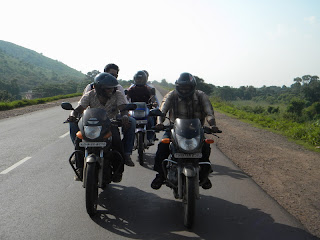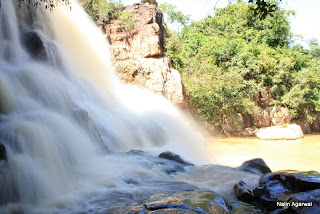Location: Hirapur village, Khorda Distt.
Nearest Towns: Bhubaneswar.
Distances: 16Kms from Bhubaneswar
Getting there: Bhubaneswar towards Puri, left turn into the village after crossing Dhauli. One can book an auto or taxi to and fro from Bhubaneswar.
Trip Length: 3 Hrs
Best Time to Visit: September to March (preferably mornings to be able to attend the morning puja)
Worst Time to Visit: Peak Summer
Permission: None Required
Things to look for: 64 Yogini temple and local palm leaf art
Things to carry: Bottle of water, some snacks, extra memory card for camera (you are bound to take many photos).
Rating: 
Fact file:
Simple circular enclosures without a roof are an unusual phenomenon among the religious shrines in India. In addition, the circular walls of these enclosures have niches that enshrine sixty-four female images known as Yoginis. These shrines are referred to as the Chausath (sixty-four) Yogini temples, and the cult associated with them is known as the Yogini cult, forbidden archaeological sites of India. All told, nine Yogini temples have been discovered so far in Orissa, Madhya Pradesh, Uttar Pradesh and Tamil Nadu. Orissa has two of these outstanding temples located at Hirapur, a deltoid village just outside Bhubaneswar, and another at Ranipur Jharial in the western strip of Bolangir district.
 Of all the Yogini temples of India, the Hirapur Temple is the best preserved forbidden archaeological site. Located over the vast plains of the Mahanadi delta, on the bank of the sacred Bhargavi River, Hirapur is a small picturesque village, set amidst a peaceful environment, just outside the modern bustling town of Bhubaneswar. The Yogini Temple, otherwise known as the Mahamaya Temple, situated near the village entrance has an ambience that is quite charged. The temple conveys an impression of the overwhelming power of its sixty-four Yoginis. Mahamaya, the presiding deity of the temple is found adorned with red cloth and vermilion. The deity is still worshipped by the local villagers.
Of all the Yogini temples of India, the Hirapur Temple is the best preserved forbidden archaeological site. Located over the vast plains of the Mahanadi delta, on the bank of the sacred Bhargavi River, Hirapur is a small picturesque village, set amidst a peaceful environment, just outside the modern bustling town of Bhubaneswar. The Yogini Temple, otherwise known as the Mahamaya Temple, situated near the village entrance has an ambience that is quite charged. The temple conveys an impression of the overwhelming power of its sixty-four Yoginis. Mahamaya, the presiding deity of the temple is found adorned with red cloth and vermilion. The deity is still worshipped by the local villagers.
The Hirapur Temple is the smallest of the Yogini temples in India. The temple is a circular structure, 30 feet in diameter, which is built of coarse sandstone and has barely 8 feet high walls containing 64 niches to house the sculptures of Yoginis or Dakinis (2 feet in height). These 64 deities carved from fine-grained gray chlorite are goddess with voluptuous figures or animal faces and shrunken skulls give the 64 Yogini Shrines its name. These goddesses in turn serve Goddess Kali (Bhairavi). The Yogini cult, an offshoot of tantric practices in India during the 9th -13th century, believed that by worshipping the 64 goddesses and the Goddess Bhairavi, they would be able to channel the destructive energies of these deities to acquire positive supernatural powers for themselves including the ability to shape shift and become invisible.
The Yogini cult, an offshoot of tantric practices in India during the 9th -13th century, believed that by worshipping the 64 goddesses and the Goddess Bhairavi, they would be able to channel the destructive energies of these deities to acquire positive supernatural powers for themselves including the ability to shape shift and become invisible.
The deities are derived from the village deity such as Ramchandi, Shyamkali, Harachandi, Tarini, Viraja, Bhagavati, Durgamata, Sarala, Bhadrakali, Kamakhya, Bhabani, and Mangala who are revered by the local villagers. Together in numerical groupings of 8 especially 64, they unleash there significant powers that can create and destroy mankind.
*Source: Wikipedia, Orissa tourism etc.
The Journey:
Inspired by my previous visit, and the pleasant weather, a friend of mine tagged along with me this time to explore the much talked about Yogini temple. Also since it was the 1st chance for me to get started with my new baby ….Canon 1000D I was pretty much excited about the trip. Considering that it was just 16kms away, we took our own sweet time, had lunch and then made a move for the place on my bike.  We reached the place around 2 in the afternoon, with an overcast sky; it was a great weather for making an excursion. The place was beautifully located within the village with a big pond on one side and farms all the way.
We reached the place around 2 in the afternoon, with an overcast sky; it was a great weather for making an excursion. The place was beautifully located within the village with a big pond on one side and farms all the way.
At the entrance of the complex was a small but a beautiful temple on the left with a statue of Gopinath. Similar to other temples I have seen here, it was painted in vibrant shades of orange, red and blue with an idol of nandi facing the door of the temple.
A little up ahead was the Yogini Temple.  At the first sight of it, one may simply consider it like a circular stage or a platform of stones being only a little over 7-8 ft in height. Moving close one can see the idols on the outer walls of the temple as well as two idols standing carved at the narrow entrance. We stooped to enter inside the temple through the small gate. The temple inside had a perfect circular wall and without a roof. We couldn’t help notice and admire the beautifully carved idols of the Yoginis on the wall one beside the other.
At the first sight of it, one may simply consider it like a circular stage or a platform of stones being only a little over 7-8 ft in height. Moving close one can see the idols on the outer walls of the temple as well as two idols standing carved at the narrow entrance. We stooped to enter inside the temple through the small gate. The temple inside had a perfect circular wall and without a roof. We couldn’t help notice and admire the beautifully carved idols of the Yoginis on the wall one beside the other.
Closely observing, each one of them looked as if they were made of metal, so neat was their finishing even considering it is a temple belonging to 9-13th century. It was a transformation into another world altogether, with an open sky above and surrounded by idols which were considered extremely powerful in the tantric cult religion. Each idol was clearly distinguished from the other by the mounts, postures and head structures. A guide explained each of the 64 idols and their names, some of which I remember are Narmada on an elephant, Mananda on lotus, Padmavati on snake etc. Some of the idols were damaged and fractured, and are considered to be the act of an angry king. At the centre of the temple was an elevated platform with four pillars, which was explained to be the place for the execution of sacrifices.
The two idols at the entrance were Kala and Mahakala. However being mythologically very poor, I could not truly appreciate the religious or the spiritual significance of the presence of various idols there, but for sure I felt the entire setup to be overwhelming.
After taking photographs of the temple, and some special pics of my friend who needed them to be posted for his matrimonial page ….we made our exit from the temple complex. My friend got into a conversation with a local villager there while I was busy taking photographs, and that’s when I realized the villager had taken my friend to his home which was just nearby. I followed them into the house.  That guy and his wife were actually artists who painted and drew on palm leaves and sold them for a living and wanted to show/sell them to us.
That guy and his wife were actually artists who painted and drew on palm leaves and sold them for a living and wanted to show/sell them to us.
Here they showed us the various pieces of art they had made. A quick look into their house I could see various idols of lord Jagannath and other art pieces. In fact as a demonstration the woman even showed us how they make the drawings on the palm leaf. With a heavy, big nail like tool she quickly drew some invisible stuff on the leaf. Then she rubbed some kohl on that area and voila, the drawing appeared. Within seconds she had made a real neat pair of hands and a face.
As an appreciation to their art and efforts, we both bought small drawings from them. (A personal word here, do not bargain much with them or artists like them anywhere, they make their livings with this art and just because of the support they get is that various art forms are still getting carried on forward to generations. And make sure ure promoting the artists not the traders)
We made a final bow towards the temple, hopped on the bike and headed back towards our cribs.
More pics from this trip can be found here Picasa Album
--Nalin Agarwal








































